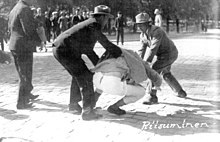From Wikipedia, the free encyclopedia
https://en.wikipedia.org/wiki/Political_repression
Political repression is the act of a state entity controlling a citizenry by force for political reasons, particularly for the purpose of restricting or preventing the citizenry's ability to take part in the political life of a society, thereby reducing their standing among their fellow citizens. Repression tactics target the citizenry who are most likely to challenge the political ideology of the state in order for the government to remain in control. In autocracies, the use of political repression is to prevent anti-regime support and mobilization. It is often manifested through policies such as human rights violations, surveillance abuse, police brutality, imprisonment, involuntary settlement, stripping of citizen's rights, lustration, and violent action or terror such as the murder, summary executions, torture, forced disappearance, and other extrajudicial punishment of political activists, dissidents, or general population. Direct repression tactics are those targeting specific actors who become aware of the harm done to them while covert tactics rely on the threat of citizenry being caught (wiretapping and monitoring). The effectiveness of the tactics differ: covert repression tactics cause dissidents to use less detectable opposition tactics while direct repression allows citizenry to witness and react to the repression. Political repression can also be reinforced by means outside of written policy, such as by public and private media ownership and by self-censorship within the public.
Where political repression is sanctioned and organised by the state, it may constitute state terrorism, genocide, politicide or crimes against humanity. Systemic and violent political repression is a typical feature of dictatorships, totalitarian states and similar regimes. While the use of political repression varies depending on the authoritarian regime, it is argued that repression is a defining feature and the foundation of autocracies by creating a power hierarchy between the leader and citizenry, contributing to the longevity of the regime. Repressive activities have also been found within democratic contexts as well. This can even include setting up situations where the death of the target of repression is the end result. If political repression is not carried out with the approval of the state, a section of government may still be responsible. Some examples are the FBI COINTELPRO operations from 1956 to 1971 and the Palmer Raids from 1919-1920.
In some states, "repression" can be an official term used in legislation or the names of government institutions. The Soviet Union had a legal policy of repression of political opposition defined in its penal code and Cuba under Fulgencio Batista had a secret police agency officially named the Bureau for the Repression of Communist Activities. According to Soviet and Communist studies scholar Stephen Wheatcroft, in the case of the Soviet Union terms such as "the terror", "the purges" and "repression" are used to refer to the same events. He believes the most neutral terms are repression and mass killings, although in Russian the broad concept of repression is commonly held to include mass killings and is sometimes assumed to be synonymous with it, which is not the case in other languages.
In political conflict
Political conflict strongly increases the likelihood of state repression. This is arguably the most robust finding in social science research on political repression. Civil wars are a strong predictor of repressive activity, as are other forms of challenges from non-government actors. States so often engage in repressive behaviors in times of civil conflict that the relationship between these two phenomena has been termed the "Law of Coercive Responsiveness". When their authority or legitimacy is threatened, regimes respond by overtly or covertly suppressing dissidents to eliminate the behavioral threat. State repression subsequently affects dissident mobilization, though the direction of this effect is still an open question. Some strong evidence suggests that repression suppresses dissident mobilization by reducing the capacity of challengers to organize, yet it is also feasible that challengers can leverage state repressive behavior to spur mobilization among sympathizers by framing repression as a new grievance against the state.
Violence

Political repression is often accompanied by violence, which might be legal or illegal according to domestic law. Violence can both eliminate political opposition directly by killing opposition members, or indirectly by instilling fear.
Intolerance
Political repression is sometimes accompanied with intolerance. This intolerance is manifested through discriminatory policies, human rights violations, police brutality, imprisonment, extermination, exile, extortion, terrorism, extrajudicial killing, summary execution, torture, forced disappearance and other punishments against political activists, dissidents, and populations in general.
State terrorism
When political repression is sanctioned and organized by the state, situations of state terrorism, genocide and crimes against humanity can be reached. Systematic and violent political repression is a typical feature of dictatorships, totalitarianisms and similar regimes. In these regimes, acts of political repression can be carried out by the police and secret police, the army, paramilitary groups and death squads. Sometimes regimes considered democratic exercise political repression and state terrorism to other states as part of their security policy.
Direct vs. indirect repression
Direct repression is a form of repression where the state targets an opposing political actor by obvious violent action. The target is clearly aware of the harm that is caused to their life and livelihood. Direct repression does not exclusively occur within the boundaries of a state, but also across borders. In personalist dictatorships, initiating conflicts with other states and people outside their own borders is more common because of lack of accountability via extremely limited or no competitive elections.
Indirect repression relies on the threat of violence which constitutes harassment, intimidation, and administrative blockages. These tactics tend to be non-violent, yet still are built to control citizenry.